The Descendants’ Stories – A Guided Walk at Bukit Brown (English)
Sunday 24 August’14 : 9 am – 11.30am
Meeting Place: Bukit Brown Gates at end of Lorong Halwa.
For those who have written in asking about when the next upcoming tours will be:
Please check this blog bukitbrown.com under events every week for upcoming guided walks. Blog posts should be up by Wednesday. Guided walks are dependent on volunteers schedules but we try our best to organise guided walks every weekend.
The fastest way to find out about upcoming guided walks is to join the Heritage Singapore Bukit Brown facebook group here . The guided walks are generated as event pages from this FB group and are always pinned on top of the page. Please note if you are using a mobile device to access the FB page, you have to click on the pinned posts to get details.
Thank you everyone who wrote in, our apologies, we are unable to respond individually.
******
To those who have registered and received confirmation, please meet by 9am. Just as you pass enter the Bukit Brown gates, on your left would be the LTA site office. This would be the gathering point of Sunday’s guided walk. See you!
This guided walk is now full.
_____
All Things Bukit Brown* is pleased to curate a new guided walk in conjunction with the exhibition “Bukit Brown: Documenting New Horizons of Knowledge”
About the Walk: News that a highway was to be built across Bukit Brown in 2011 led some descendants who had lost touch with their ancestral tombs to embark on a quest to find them. Some of those who were successful shared their stories of reconnecting with their ancestors and family oral history with the volunteers on the ground, called Brownies.
In this tour, Brownies will share stories recounted to them by descendants they have met and who have become friends. But the highlight of this guided walk is the descendants, who will share their stories first hand at the tombs of their ancestors.
Noreen Chan is the descendant of a long line of influential and wealthy “compradors” – the business relationship managers of the old banking regime. At the tomb of Chia Hood Theam, Noreen will recount stories of her maternal great-great grandfather’s frugality and contributions to women’s education from family oral traditions and historical records.
In Tiong Bahru, Singapore’s earliest housing estate, is a street named after Lim Liak (Leack). Lim Soon Hoe, a descendant of the 6th generation, will unravel the history of Lim Leack’s contributions to the mining industry in the region and his personal search for the family’s private burial grounds in a place today translated as “New Cemetery”.
The Brownies will reveal who is the inspiration behind Emily of the award- winning play “Emily of Emerald Hill” and share how a descendant “re-fengshui’ed” her great grandfather’s tomb upon discovery in 2012.
The guided walk will end at the largest family tomb cluster in Singapore, the “Ong Sam Leong” tomb cluster featured in the exhibition poster – the jewel in the crown of Bukit Brown due to its sheer size.
****
Disclaimer: By agreeing to take walking tours of Bukit Brown Cemetery, I understand and accept that I must be physically fit and able to do so.To the extent permissible by law, I agree to assume any and all risk of injury or bodily harm to myself and persons in my care (including child or ward) Please read if you are attending our guided walks for the first time, useful info on safety : Getting There/游览信息
*All Things Bukit Brown is the banner for a group of volunteers called “Brownies” who conduct regular weekend guided walks and do independent research on the heritage, habitat and history of Bukit Brown. To date, they have guided almost 12,000 people since they started their guided walks at the beginning of 2012.
As part of the exhibition, Bukit Brown: Documenting New Horizons of Knowledge, a series of English (Sun 17 Aug’ 14) and Mandarin ( Sat 20th Sept’14) Public Talks have been programmed by the documentation team under Dr. Hui Yew-Foong.
Location: Possibility Room on Level 5
(Look out for guided walks in English and Mandarin specially curated by All Things Bukit Brown to complement the exhibition/talk when you attend the talks,details to be posted later)
Date: Sunday 17th August (English) Registration here (through eventbrite)
2-3pm Speaker: Dr Hui Yew-Foong
Bukit Brown: Documenting New Horizons of Knowledge
3-4pm Speakers: Dr Natalie Pang and Dr Liew Kai Khiun
The Internet and Bukit Brown
4-5pm Speakers: Lim Chen Sian and Angela Goh
Digging Bukit Brown
5-6pm Speaker: Mok Ly Yng
Documenting Bukit Brown: Maps and Mapping
Saturday, 20 September 2014 (Mandarin) Registration here through eventbrite
2-3pm Speaker: Dr Lai Chee Kien
Tomb Architecture
3-4pm Speaker: Ang Yik Han
Story Telling Stones – Tales from the Stone Carvings of Bukit Brown Cemetery
4-5pm Speaker: Mok Ly Yng
Documenting Bukit Brown: Maps and Mapping
Selected Abstracts and Bios
Bukit Brown: Documenting New Horizons of Knowledge
This talk introduces the various findings that have emerged from the multi-disciplinary study of Bukit Brown Cemetery. The speaker will share highlights from oral history interviews, field documentation of graves and fieldwork studying rituals performed at Bukit Brown. At the same time, the talk will demonstrate how various techniques and technologies employed in the course of documentation has enhanced the collection of data.
Dr Hui Yew-Foong is Lead Researcher of the Bukit Brown Documentation Project. He is an anthropologist by training, and has conducted fieldwork in Indonesia, Malaysia, China, Hong Kong and the US. Prior to taking up the documentation of Bukit Brown Cemetery, he was involved in leading a group of volunteers to document Kwong Hou Sua Teochew Cemetery before it was fully exhumed. Dr Hui is the author of Strangers at Home: History and Subjectivity among the Chinese Communities of West Kalimantan, Indonesia.
Tomb architecture
The material culture at Bukit Brown cemetery, including tomb architecture, is unique and offer many insights on Singapore’s social, cultural and economic connections to the region and to Southern China and Singapore. This talk discusses the documentation of tomb architecture at Bukit Brown and the importance of such records. There are also opportunities for children at this talk to learn about tomb architecture using paper models.
Dr Lai Chee Kien is a registered architect, and graduated from the National University of Singapore with an M Arch. by research [1996], and then a PhD in History of Architecture & Urban Design from the University of California, Berkeley [2005]. He researches on histories of art, architecture, settlements, urbanism and landscapes in Southeast Asia.
National Day Celebrations@ Esplanade is here again with an exhibition :”Our Brick Estate” and a series of talks on Sunday 10th August’14
Venue: library@esplanade (Open Stage)
Sunday 10th August’14: Talks
3pm – 3.45 pm
Our Brick Estate by Lai Chee Kien (赖启健)
Our island-city’s early foundations were laid at a time when the building material industry flourished. Join architectural and urban historian Lai Chee Kien as he traces the history of our local brick industry, from the early colonial period when they were handmade, to their industrial production and extensive use during our early days of nation-building.
This talk will be accompanied by an exhibition of the same title for the month of August.
4.30-5.15pm
Grandfathers’Roads : Legacy of Our Pioneers by Raymond Goh
Raymond Goh has been studying the legacies behind famous roads that have been named after the revolutionaries, war heroes, and builders of Singapore. Join him as he shares interesting stories behind some of them. Raymond is a specialised heritage tour guide who conducts tours for schools, community clubs and societies.
6pm – 6.45pm
Once Upon a Yesterday by Alex Tan Tiong Hee
Share your comments and sentiments with Alex Tan as he navigates the nation’s past in Once Upon A Yesterday, an interactive story tracing some of the historical events significant to Singapore’s socio-political environment in the 1950s, as seen through the eyes of a young boy. Alex graduated in law and is a trustee of the Settlement of Dr Lim Boon Keng (1921) and a committee member of the Singapore Heritage Society.
Preamble : Hungry Ghost Festival
Saturday, 26th July was the eve of what is popularly known as the Hungry Ghost Festival, and less well known by its traditional name of Zhongyuan Jie, which in essence is also about honouring ancestors. It takes place at the start of the Chinese 7th lunar month, and it is when the gates of hell open and the spirits of dead are free to wander among the living for a month. To appease them, offerings and entertainment is laid out by descendants at their homes, but also by temples, business and clan associations. This year, the prediction was that hell’s gates will open at 11pm on the eve of the festival.
The Salvation Rituals
At Bukit Brown, devotees from the Taoist temple Xuan Jiang Dian (Heng Kang Tian ) conducted a “chao du” or “salvation rituals” – considered an act of compassion – specifically for the forgotten and lost spirits there.
This is the 3rd year in a row, Xuan Jiang Dian have done this, ever since in fact news of the building of the highway across Bukit Brown in 2011 was announced. Exhumations of the some 4.153 graves which are in the way of the highway are drawing to a close. So there was added interest in this year’s ritual which was covered by our national newspapers. The National Heritage Board (NHB) shared that a specially commissioned video on rites and rituals at Bukit Brown will be uploaded soon to you tube.
A First Hand Account of “chao du”
The ” chao du” ceremony which was witnessed also by Brownies and other well wishers, started at around 8.3opm . It consisted of the setting up of an altar table with offerings at the major junction of the 4 roads in Bukit Brown which leads to Blocks 1, 5, 4 and 3.
The Taoist priests from China, resplendent in their robes, chanted and walked several ceremonial rounds in the area calling upon lost spirits. There was something soothing in their chanting and the air was redolent with the scent of what must have been a hundred lighted joss sticks. Each participant carried 3 sticks each throughout the 40 minute long chanting.
There was a stillness in the air and the smoke and swish of the robes carried the movement of the night. It ended with the burning of paper offerings and just as quickly as it was set up, the devotees packed up and left, with the the candles planted still burning and the last vestiges of the paper offerings smouldering down to embers.
******
Photo Gallery :

Side View : Off site 3 tablets, set up by Xuan Jiang Dian at Bukit Merah Blk 123 for the wandering spirits of Kopi Sua aka Bukit Brown. [right] for animals killed during agricultural activity (prior to it becoming a cemetery)[centre] for wandering souls[left] for animals killed during construction works (photo and caption by Chua Ai Lin)
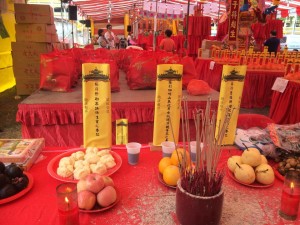
Front View : Off site 3 tablets, set up by Xuan Jiang Dian at Bukit Merah Blk 123 for the wandering spirits of Kopi Sua aka Bukit Brown. [right] for animals killed during agricultural activity (prior to it becoming a cemetery)[centre] for wandering souls [left] for animals killed during construction works (photo Raymond Goh)
Report on Lianhe Zaobao on a ritual conducted last night at Bt. Brown which marked the opening of the 7th month: A group from Heng Kang Tian including 8 Taoist priests conducted the ritual to invite spirits to a salvation ceremony conducted today in front of Bukit Merah View Block 123. The group has been going to Bt. Brown for the past two years to invite spirits from tombs which are not tended to by descendants. The event was attended by Brownies and participants of tours at the cemetery. It was also recorded by the Bt Brown Documentation Team. NHB is currently preparing a 10-15 min documentary on the rituals carried out at Bt Brown cemetery. This will be uploaded to the NHB channel on youtube, “yesterdaysg”, around end next month. (summary by Ang Yik Han) Full report in Chinese:
文物局到武吉布朗坟场 记录“招魂”仪式
王舒杨
联合早报2014年07月27日
今天是农历七月初一,华人传统节日“鬼节”今起开始。昨晚,武吉布朗坟场文史记录小组和国家文物局人员特地到武吉布朗坟场,记录一场由道教团体进行的祭祀仪式。
昨晚约9时,应道教宗教团体玄江殿邀请的八名道长和一名唢呐乐师在武吉布朗坟场进行“招魂”仪式。在道路两侧点亮“引魂”的香火后,他们在锣鼓声中唱诵经文。今明两天他们将在红山景第123座前的道场举行大型超度法会。
数十名积极参与保护武吉布朗文化遗产的公民团体成员也到场目睹仪式。除了这些“武吉布朗人”,不少报名参加坟场导览活动的外国人和游客也纷纷拿起相机拍下这个独具特色的活动。
玄江殿自1996年起多次在武吉布朗坟场举行农历十月初一的“寒衣节”祭祀活动,并从两年前开始在武吉布朗坟场举行七月鬼节的法事,目的是在坟场进行招魂,为他们超度。
根据武吉布朗坟场文史记录小组整理的资料,武吉布朗坟场里的中元节如同一项社区活动,是一种灵界上的慈善事业。信徒所祭祀的亡魂通常与他们没有任何亲属关系,尤其是孤魂。
玄江殿主持陈荣兴(45岁)说,武吉布朗一些坟墓主人没有子孙祭拜,所以希望能为这些孤魂超度。
此外,道家也相信所有生灵皆可超度,而坟墓挖掘过程中伤到蚂蚁等生灵,超度法事也怀有对它们的尊重。
国家文物局目前正在筹备一个10至15分钟长的纪录片,介绍华人社群在武吉布朗坟场的仪式,包括七月鬼节、清明节以及较少人知道的寒衣节。短片料下月底上载到文物局的YouTube频道“yesterdaysg”。
文物局总司长(政策)陈子宇说:“武吉布朗坟场不仅仅是一个埋葬地点,也是华人社群进行祭祖等仪式的地方。我们会记录这些仪式,以继续丰富我们有关新加坡非物质文化遗产的数据库。”
公众可通过在国家图书馆大厦9楼展出的“武吉布朗:记录新知识 开拓新视野”中英文展览,了解武吉布朗坟场上世纪的演变、坟墓设计和民间风俗等。图书馆大厦展览在10月10日结束后,将陆续在宏茂桥、裕廊、蔡厝港和大巴窑图书馆展出至明年1月底。
Romancing Taiping (Part 1)
A photo essay by Simone Lee
“I was a little apprehensive at the beginning. Even as a Malaysian, I’ve never heard of anyone raving about a visit to Taiping. But while we were there, I fell in love…………” Simone Lee (Brownie*)
Taiping History (in brief)
Plagued by fierce feuds ( The Larut Wars) between 2 prominent Chinese secret societies(Ghee Hin and Hai San, this once flourishing town in Perak, which prospered from tin mining was said to have been named Taiping – 太 (tai – ‘great’) and 平 (ping – ‘peace’) – after a truce was brokered in the Pangkor Treaty. The treaty was the result of a politically motivated call for British intervention aided by a friend from Singapore, Tan Kim Ching (son of Tan Tock Seng).
Day 1: Taiping Town and Kuala Sepetang
At the sleepy town, we met our guide, Ah Kew (Lee Eng Kew), a freelance writer and field historian. Our first stop: The Old House Museum. One of the earliest 3-storey shophouses built in Taiping, the museum/antique shop retains much of its original architecture.
(please click on images for full size photos and captions)
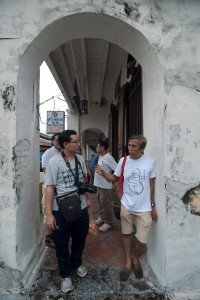
Our very knowledgeable and generous guide Ah Kew (pictured on the right) , who was to share with us personal insights into Taiping’s history and cultural links (photo Simone Lee)

Clockwise from left): – 1) Much of the shophouse, including the wooden spiral stairs are retained 2) A room filled with miniature cars and dolls – 3) Posters of artists and celebrities from the 60’s and 70’s line the corridor (photos Simone Lee)
Charcoal Factory
The next stop surprised everyone. As we drove into the compound of a charcoal factory, the scene took our breath away. The smoke from the kilns filters the sun rays, reminding me of movies with scenes of a dreamy, foggy mornings by the lake, embraced by mountains.
Here, Ah Kew explained the charcoal making process which typically takes several weeks before it is ready to be marketed. In the process, a by-product “‘charcoal water” is distilled from the baking wood. It is bottled and sold as a beauty product – slightly acidic but gentle enough to be used on the skin. I tried some on my face and arms, and instantly my skin felt supple, toned and smooth! Feeling vain, I wanted to order a bottle, which was selling at just RM5, the retail outlet was closed.
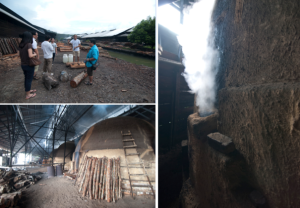
(clockwise from top-left): – 1) Ah Kew explains how logs from the mangrove trees are brought to the factories by boat via the stream.2) Steam from the kiln gushes out as the wood is baked so moisture, evaporates. 3) The igloo-shaped kilns in one of the factories (photos Simone Lee)

Kuala Sepetang’s Matang Mangrove Forest is the largest mangrove forest reserve in Malaysia and was gazetted as a Permanent Forest Reserve in 1906. (photo Simone Lee)
At the mangrove forest, Ah Kew regaled us with stories of 2 notorious pirates with fearsome reputations in the post war era.
Tan Lian Lay once hid bags of rice in a mangrove forest but they were destroyed when the tide rose. After his death, he was immortalised as a deity because his spirit was giving out winning numbers in repentance for his sins. It has been said Tan Lian Lay was also a trouble maker in Singapore. When he was killed in Bagan Api in Riau, Sumatra, a well- wisher from Singapore sent gifts as a reward for slaying Tan Lian Lay’s reign of terror.
Tan Hua Siea aka Raja Laut (King of the Sea) monopolized the shellfish farms and was on Perak’s most wanted criminal list. Despite that, he eluded capture, sheltered by the locals. Even though he was always dangerously armed, he never terrorised the villagers and was revered as the Robin Hood of the coast. What happened to him remains a mystery to this day.
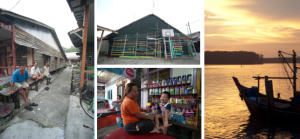
The idyllic village belies its checkered sometimes violent past as hideouts for pirates. (photos Simone Lee)
***
Look out for Romancing Taiping Part II next week
***
*The Brownies’ yearning to connect to history and thirst for adventure, brings them to various locations within and beyond Singapore. The objectives of these retreats are, to study the historical and cultural links to Singapore, and to strengthen kinship amongst the brownies.
(Brownies are the volunteers who conduct regular weekend guided walks and independent research on heritage, habitat and history of Bukit Brown Cemetery.)
Bukit Brown : Documenting New Horizons of Knowledge
Location: NLB 9th floor from now until 10 October’14 and thereafter it will travel to other regional libraries.
The exhibition was officially opened on Saturday 19 July,2014 by MOS (Ministry of National Development) Desmond Lee.
It represents almost one and half years of research and working the ground documenting some 4,153 tombstones which are affected by the building of a new highway across Bukit Brown, by a team under the leadership of Dr. Hui Yew-Foong, an anthropologist with ISEAS.
We have observed the team hard at work over these years, joined some of them during Qing Ming and exhumations as observers and friends of the family of descendants, and the exhibition is a comprehensive and compact expression of what they have uncovered, shared with the public with insight and interesting artefacts , enhanced by new technology. We recommend it as a “must see” and “ground breaking” for insights shared of customary practices and traditions of burial customs and respect for ancestors.
An extract from the media release:
Documenting New Horizons of Knowledge” assembles a diverse range of documents,maps, photographs and objects to demonstrate how a cemetery can open a window to Singapore’s historical past and cultural present. Through a multi-disciplinary approach employing cutting-edge methods, techniques and technology, the exhibition will bring to the fore new horizons of knowledge unveiled through the documentation of Bukit Brown.
The exhibition opens with the origins of the cemetery, as a project of the Municipal Commissioners in early 20th in 1973, will be illustrated through maps and aerial photographs. Next, through explication of tomb inscriptions, tomb typology and the material culture of the cemetery, the exhibition will demonstrate Singapore’s connectivity to the region, China and the world.
While the cemetery is a burial space for the dead, it is also a space for the living at different points of Singapore’s history and ritual calendar. This will be illustrated through the life of kampongs that used to be situated in the vicinity of the cemetery and the life of the cemetery during Qing Ming and the Seventh Month Hungry Ghost Festival.
As data for the graves was collected and organised within a Geographic Information System (GIS) framework, the exhibition will present a Centrepiece where visitors will be able to access data related to specific graves through a map-based database on a touch screen monitor.
Finally, visitors will get a glimpse behind the scenes of documentation work, to get a sense of the different methods, techniques and technologies that were employed in the course of documentation. These range from balloon photography to 3D scanning, from interviewing to filming, and from the work of architects to the work of archaeologists.
****
Highlights of the Exhibition Opening
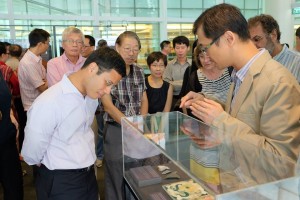
Dr Hui Yew-Foong, explaining material culture to MOS Desmond Lee during the curator’s walk through (photo Ang Hock Chuan)
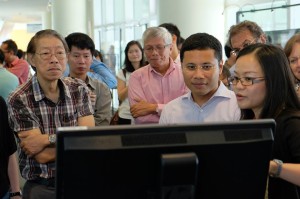
Dr. Natalie Pang (NTU) who worked on the IT applications for the centerpiece map demonstrating how it works to MOS Desmond Lee (photo Ang Hock Chuan)

The urn which used to house re-interred remains from other cemeteries to Bukit Brown (photo Raymond Goh)
This urn was used to re-inter bones exhumed from an older cemetery. It was from the grave of Madam Khoo Siok Hui, who died in 1836. Her grave was the oldest among those documented at Bukit Brown. Madam Khoo and her son Chee Yam Chuan were among the early settlers of Singapore. Mr Chee later returned to Malacca and made his fortune in tin mining in Selangor. Today, the Chee Yam Chuan Temple Trust continues to flourish in Malacca and Madam Khoo’s ancestral tablet can be found in the temple. The story behind this family shows the close links between Malacca and Singapore in the early years. It was Raymond Goh who first deciphered the inscription and unraveled the connection.

Treasure trove of jade bracelets worn by the women and traditionally buried with their wearers. (photo Ang Hock Chuan)
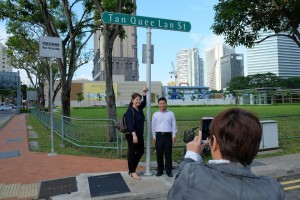
Descendant Serene Tan of pioneer Tan Quee Lan, gets one for the album when MOS Desmond Lee sportingly agrees to walk with her to visit her “great great grandfather’s road” ( photo Ang Hock Chuan)
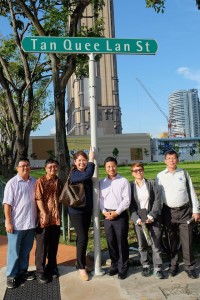
They were accompanied by a entourage of brownies who have been sharing Serene’s journey of reconnecting with her ancestors since Raymond Goh found the Tan Quee Lan cluster re-interred from another cemetery at Bukit Brown (photo Ang Hock Chuan)
A video at the exhibition features Serene Tan and her family observing the first Qing Ming at Bukit Brown in 2012 after Raymond Goh discovered the cluster of Tan Quee Lan tombs, and shows how the cluster underwent a renovation makeover by Serene and her cousin LT Tan who met at Bukit Brown itself. Serene’s story can be read here
The cluster is not affected by highway.
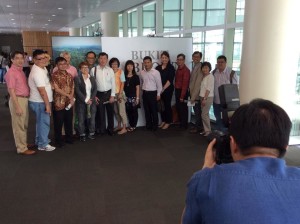
Brownies, academics, descendants, members of the documentation team at the exhibition (photo Khoo Ee Hoon)
“….to everyone who came and supported the launch, and most importantly, supported us and helped us generously with our research over the last 33 months. One of the purposes of the exhibition is to acknowledge all your contributions and I hope it accomplished that.” Dr Hui Yew- Foong, Curator of Exhibition on a FB posting.
Look out for 2 specially curated walks by the Brownies in conjunction with the exhibition in August (English) and September (Mandarin).
Photos taken of the exhibition courtesy of Brownie Ang Hock Chuan on Facebook here
Read more about the exhibition by the Rojak Librarian here
Disclaimer: By agreeing to take walking tours of Bukit Brown Cemetery, I understand and accept that I must be physically fit and able to do so.To the extent permissible by law, I agree to assume any and all risk of injury or bodily harm to myself and persons in my care (including child or ward) Please read if you are attending our guided walks for the first time, useful info on safety : Getting There/游览信息 If you have a facebook account please register on the FB links provided unless otherwise stated. There is also a walk by post museum in the after, please see details below for registration.
For all walks:
Please bring umbrella or poncho and sun protection.
Please wear covered footwear.
Please bring mosquito repellent.
Please bring sufficient drinking water.
Meeting place for all Walks : At the Lor Halwa Main gates at Bukit Brown
Sat 26 July’14 : 6.30pm – 8.30pm : A Journey into the Past with Andrew Lim
Follow Andrew for an evening stroll through Bukit Brown cemetery where he will share stories of the Past. We will go to a “mystery” location if time permits.
PLEASE BRING TORCH LIGHTS FOR THIS WALK
FB registration here
Mon 27 July’14: 9am – 11.30 am: Peranakan Tile Appreciation with Victor Lim
Join Victor Lim on his tour through the cemetery where he will focus on the various tiles used in the tomb designs.
Learn more about “Peranakan” or majolica tiles from our tiles expert!
FB registration here
Read more about the tiles here
by Norman Cho
In 2011, I discovered the grave of my paternal grandfather, Cho Kim Leong at Bukit Brown Cemetery. Since then, I have been trying to locate the tomb of his father, Cho Boon Poo (Cho Poo), who was laid to rest in Malacca. I had absolutely no clue as to which cemetery he was buried. Bukit Cina and Jelutong cemeteries came to mind but these are huge cemeteries with more than a hundred thousand graves each. They are maintained by the Cheng Hoon Teng Temple but pre-war records are unavailable. It seemed that I had hit a dead-end!
However, miracles do happen. To me, these are little blessings from above. Perhaps, the old man had wanted his descendants to visit him and had influenced how things turned out. It must have been decades since the last time any descendants paid their respects at his tomb. He must have known my sincerity and had helped me along without my knowledge. The breakthrough came in April 2014. A relative whom I had never known, contacted me via Facebook to introduce himself as the maternal great-grandson of Cho Poo, after he had discovered that we have matching ancestors from an online Family Tree software on the internet. 70 year old Vincent Lee was descended from Cho Poo’s eldest son, Cho Kim Choon, while my paternal grandfather, Cho Kim Leong, was the third son. He resides in Australia and was planning a trip down to Singapore in April 2014. He requested my assistance to put him in touch with the relatives in Singapore.
It turned out to be a blessing for me! I talked to my eldest aunt, Rose Cho (88 years old), to ask for the contacts of other relatives from the Cho clan. That was how I found aunt Elizabeth Cho (62 years old), who was the only child from the fifth son, Cho Kim Hock, a famed state badminton player for Malacca in the 1930s. We organised a dinner for our overseas relative and his wife. During dinner, I had a nice chat with Elizabeth – whom the family affectionately calls Bert – about Cho Poo. She told me that her only visit to his grave was when she was a child of 9 years old. That was more than 50 years ago! Her father who was the only surviving son at that time dreamt of his father asking him why he had not visited him in such a long time. Heeding the call, he brought his wife and daughter to pay their respects to his father. Since then, he had visited the grave alone every year till several years before his death in 1990.
Aunt Elizabeth, had the memory of an elephant! She vividly recalled that the cemetery was about a 40-minutes-drive from the Malacca Town, but had no inkling about the name of the cemetery. She further described that the cemetery was sliced into two by the main road, there was a cemetery on the left and another on the right, and Cho Poo’s was on the right. The tomb was relatively large and on a gentle-sloping plain. It faced a vast and beautiful paddy field. She added that the cemetery was on the land which once belonged to Cho Poo and was probably the private burial ground of the Cho family. Later, when the family was not doing well financially, it was sold to the Malacca’s Eng Choon Hway Kwan and it became a cemetery for the Eng Choon community. She thinks that the tomb should still be there, given the leisurely pace of development in Malaysia. She asked if I would be able to find the tomb. I told her that I could try. All her clues were useful, except for the paddy field. I told her that I doubt the paddy field in her memory still exists. Nevertheless, I took whatever clues that I could use and converted them into intelligent information.
Firstly, I eliminated Bukit Cina as it was near Malacca Town and therefore could not be a 40-minutes-drive. Next, I looked at the map of Jelutong cemetery but it was not sliced into two by any road. I asked a few Malaccan friends of other lesser-known cemeteries and searched the Google Map for them. Finally, I found a relatively small cemetery, probably no larger than 20 acres, which was dissected by a main road. It was away from the Malacca Town and would probably take about 30 minutes to get there by car. This was the Krubong Cemetery. To be certain that I had located the correct cemetery, I contacted a Malaccan friend who verified that this cemetery is indeed managed and owned by the Eng Choon Hway Kwan. He helped me to obtain the mobile contact of the tomb-keeper to locate the grave. With modern technology, I communicated with the tomb-keeper via Whatsapp to economize on the phone bill. Amazingly, he found the tomb the very next day. The search was completed successfully in less than a week since I started piecing the information together!
I informed aunt Elizabeth who was extremely excited and delighted with the news. We decided to go on a trip to Malacca to pay our respects to our common ancestor, Cho Boon Poo. He was the first ancestor who came to this part of the world to carve a better life for himself and his family. By braving the elements to come to the land across the Southern Seas, he had changed his destiny and that of all his descendants. It was through sheer grit and hard work that he built a successful business and owned vast plantations in Malacca and Seremban dealing in palm leaves, gambier, tapioca and rubber. We all had to be grateful to him for being able to lead good lives in Malaya and Singapore for six generations and counting. He married nyonya wives and that was how my Peranakan roots came about. Being a strict father, all his children were well-brought up and a few of his descendants took on key positions in the civil service.
I was told how strict he was about punctuality. The family would have dinner at 7pm sharp and everyone was expected at the table. Nobody could join in once dinner was served. If you missed dinner, it meant that there would be no dinner for you. During one occasion, his fourth son, Kim Tian came home late but the kind servant saved some food for him. When found out, the servant was sacked. He had a strong character and was on the board of the executive committee of the Eng Choon Hway Kwan.
We arrived at his grave on the morning of 23 June 2014 and I noticed that his tomb was the largest amongst the 50-odd tombs in the vicinity.
What captivated me were the Peranakan tiles (Majolica tiles) which adorned his tomb. No other tombs in the surrounding area had this feature. I was told that having Peranakan tiles on the tombs was not widely popular with the Malaccans. Unlike in Singapore, figurines of the Golden Boy and Jade Maiden were conspicuously absent in Malaccan tombs of even the very wealthy. The tomb used to face water-filled paddy fields which are supposed to be auspicious – water and rice. Unfortunately the paddy fields had since given way to modern development. Cho Poo’s tomb seems to be steep in Fengshui elements : the front courtyard of the tomb forms part of a hexagon instead of the normal rectangle or semi-circle. Along the perimeter of the front courtyard lies a water catchment channel which would collect water when it rains. This had since been covered with soil. The tomb shoulders are angular but eventually taper to form convoluting arms that seem to embrace the courtyard. Likely, it symbolizes a firm hold on wealth.Through the tomb inscriptions, I found the names of one of his wives (Lee Hong Neo) and that of the male descendants – sons, grandsons and even great-grandsons! He died at the age of sixty-nine in 1930. My aunt offered joss-sticks and joss-paper as a form of respect to our ancestor.
This trip has been very fruitful not only about finding out more about Cho Poo and paying our respects to him, but it has built a closer bond between aunt Elizabeth, her husband and I, even though we had known each other only recently.
More on Norman Cho’s journey of discovery, here
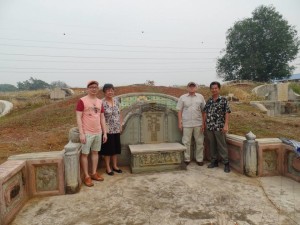
Family photo taken with the tomb-keeper. (L-R): Norman Cho, Elizabeth Cho-Tan, Peter Tan, Tomb-keeper Liow. (photo Norman Cho)
Disclaimer: By agreeing to take walking tours of Bukit Brown Cemetery, I understand and accept that I must be physically fit and able to do so.To the extent permissible by law, I agree to assume any and all risk of injury or bodily harm to myself and persons in my care (including child or ward)
Please read if you are attending our guided walks for the first time, useful info on safety : Getting There/游览信息
If you have a facebook account please register on the FB links provided unless otherwise stated.
Meeting place for all Walks : At the Lor Halwa Main gates at Bukit Brown
Sun 6 July 9am – 11.30am : Following our Early Pioneers in Bukit Brown
Join Keng Kiat and Bianca for a walk and listen to stories of our early pioneers.
————————–
Please note that there is a Thai television crew that will be following and filming our tour.
If you have a facebook account please register on the event page here
by Raymond Ang
We visited Bukit Brown on a warm Saturday morning on June 7th , to find that the usual scene to the cemetery gates changed. There are now fences leading all the way to the gates. Clearly the construction for the highway has started.
I had brought my students from the Jakarta Nanyang School here to Bukit Brown to learn more about the links between Indonesia and Singapore. The students sweltered in the humidity. I had two groups and one group had lost their way. They had set off from Nanyang Girls’ High School and one of them took a wrong bus.
Beng from the heritage group for Bukit Brown arrived on his bicycle dressed in green cargo pants and wellies. He wore “the” plastic Casio digital watch – the one I wore growing up in Secondary school. He had jerry rigged a plastic bottle to act as a mud guard for the rear wheel of his bicycle. I knew I was going to like him already.
Just as Claire arrived in a taxi, the group that was lost called me on the phone. They were still trying to figure out where they are. Their teacher was from Jakarta too and didn’t know her way around. We decided to start the walk with the one group of students first.
Claire led the way and started to draw connections between the pioneers’ lives, history and culture in Singapore and Indonesia for the students. The tombstones started to mean more than just a random collection of stone, concrete and tiles. The Japanese attack and occupation of Singapore was a large theme – Mr Tay Koh Yat had fled to Batavia on the second last day of the fall of Singapore.
Mr Lee Kuan Yew had family ties in Indonesia. Though bothered by mosquitoes and the heat, the students trudged on. Beng brought out his insect repellant and sprayed the students down. I had told the students to bring some repellent yesterday, but I guess no one did.
We found out that the other group were on the other side of the hill – Mount Pleasant. Beng offered to go get them and dashed off on his bicycle. Claire drew the connections between saga seed and karats for diamonds; between colourful European tiles, Japanese innovation and adaptation and the Ming Chinese influence on Dutch kitchen tiles.
We visited Ong Sam Leong’s tomb and learned about fengshui and distinctive role of Sikhs in Singapore’s colonial history. This is the Nanyang style. One of my students asked me what would happen when the highway gets built. I replied that all this would disappear eventually – she didn’t seem to quite understand. “But it is interesting”, she said. “Yes I agree. I don’t think there is anything else quite like it in the world.” She frowns. “So it would all be gone?”. I nodded. It was sweltering hot. Some of the students were running low on water. Beng pulls out his canteen and starts topping up bottles. I feel very grateful and touched, but wasn’t sure how to express that. So I just smiled and made a mental note.
We ended the tour with a visit to Mr Tan Chor Nam’s tomb. It is simple and distinctively modern. A rectangular plot with a black rectangular headstone. No angels nor lions here. Herein lies one of the founders of Nanyang Girls’ High School. I asked the students to observe the differences between this tomb and the others we have visited in the morning – they could clearly see the difference. The principle of Nanyang Girls High (Singapore), Mdm Heng had told me once that Mr Tan Chor Nam had died a simple man – apparently he had dedicated a large part of his fortune in setting up the school. I tried to draw the connections between Nanyang Girls’ High School and the sister school in Jakarta, and asked the students to maybe think about how they would like to be remembered in the future.
For me Bukit Brown is a reminder that we stand on the shoulders of giants who have come before us, and shaped the environment in which we have grown and “become”. “What would your legacy be?” I asked? The students looked back at me without speaking. It was a serious question. Maybe too serious. I smiled and said, “alright, you don’t have to tell me. Just think about it.” I hope they do.
****
Raymond Ang, a Singaporean, is the Head of Experiential Education Centre at the JNY, the Jakarta Nanyang School. He requested a visit to Bukit Brown when his students were on a week long learning journey to Singapore. Brownies Claire Leow and Beng Tang, who stepped up to the plate, despite the late notice, were very impressed with how engaged the students were and their independence as they had to find their own way to Bukit Brown.
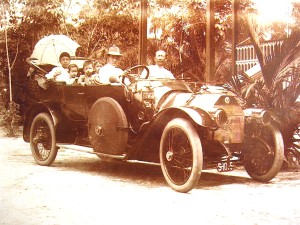
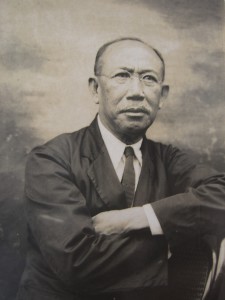
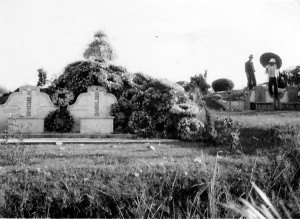


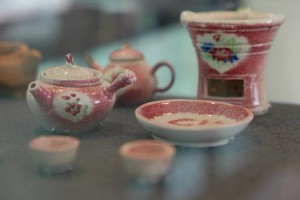


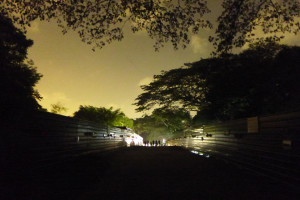
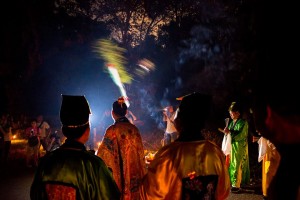

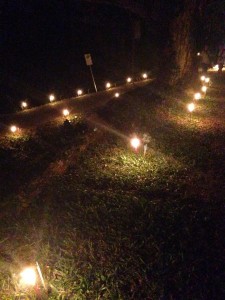
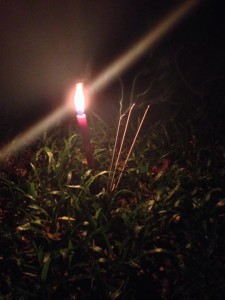
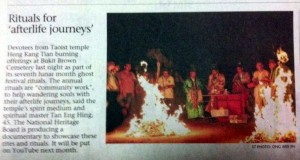
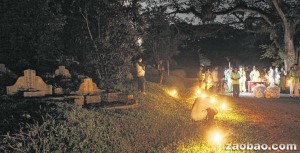
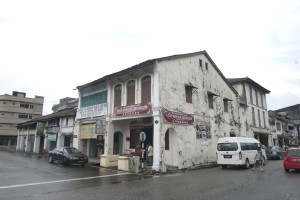

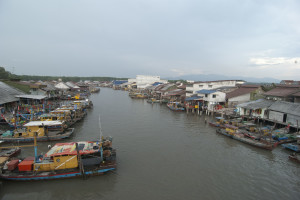
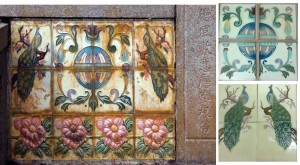
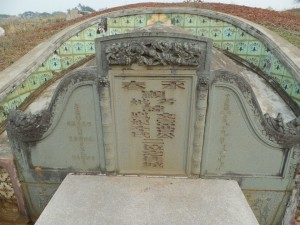
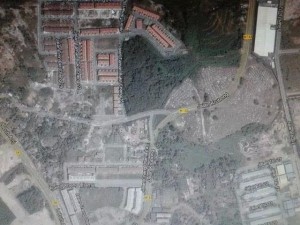
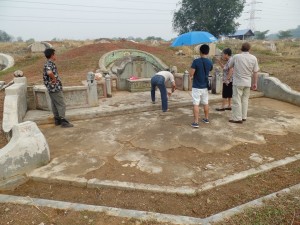
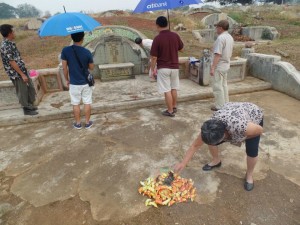
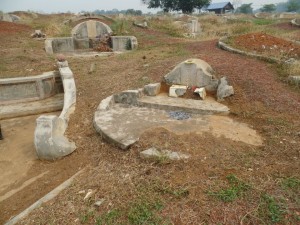


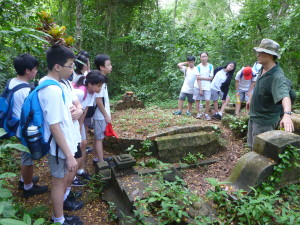
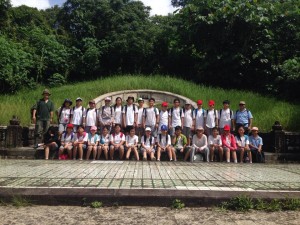
Recent Comments